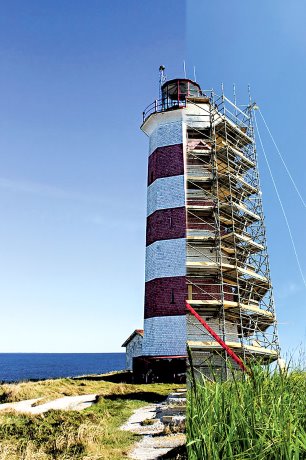A project to conserve a vital symbol of Canada’s maritime history is now well past the halfway point. But restoring the 258-year-old Sambro Lighthouse is a logistical challenge as it’s located on island of the same name just outside of Halifax Harbour.
For Quinan Construction Company, the Orillia, Ont.-based general contractor, that means ferrying its workers by boat and transporting equipment and materials by barge and helicopter.
"More than 150 trips by helicopter have been needed for the scaffolding alone," says Charles Hazell, principal, Taylor Hazell Architects Ltd. the architect of record.
Constructed in 1758, the lighthouse is the oldest continuously operating one in North America and has been beacon of safety for ships entering the habour all that time.
But the stone and reinforced concrete building also has serious structural defects and rectifying those problems was the reason the former Conservative federal government allocated $1.3 million for repairs including restoring the tower’s stone structure and its concrete foundation, says Hazell.
In the fall of 2015 the architectural firm and its project partner, Read Jones Christoffersen Ltd., recommended a series of restoration and repair procedures which were ultimately approved by government.
Although there have been a number of restoration programs implemented during the past 30 years, neglect and exposure to an aggressive salt-laden water environment has left much of the lighthouse susceptible to moisture and corrosion related deterioration, says Michael Pond, a principal with Read Jones Christoffersen Ltd. (RJC).
This includes deterioration of "character defining metal elements" such as the lantern enclosure, the gallery level guardrail, and interior stair structures, as well as the reinforced concrete tower structure.
There are actually two vintages of construction, both seriously weakened, says Pond.
The original 12-metre-high tower is comprised of rubble stone walls. In 1906 the tower was extended by an additional six metres using conventional reinforced concrete.
Then, in 1950, a one-metre-high 40-centimetre-thick reinforced concrete collar was installed at the base of the tower to help stabilize it. But this collar is now in an advanced state of deterioration through freeze-thaw damage, corrosion, and aggressive alkali aggregate reactivity (AAR) contamination/degradation.
"A certain type of aggregate in the concrete is susceptible to swelling in the presence of water," says Pond, in providing a basic layperson’s description of AAR.
At this point, the deterioration is "a durability issue, not a structural one." But the deterioration would only become worse if not addressed and eventually the reinforcing steel would corrode and the structural integrity of the concrete impaired.
"It’s like a cavity in your tooth," says Pond.
As part of its condition assessment report, RJC concluded the outer 15-centimetres of the collar needed to be removed. That is the task now being carried out by the general contractor, which came on site in early July.
Using jack light chipping hammers, its subtrades are chipping out the concrete on the octagonal-shaped tower on a "side by side" basis. This task has to be interspersed with the contractor’s other duties which involve more than just masonry work, says Pond. The next phase in the conservation of the collar will be the installation of a high-performance repair mortar. It’s a micro-silica high performance pre-packaged concrete mix intended to reduce "electrical conductivity"—in other words chloride and moisture penetration—and improve the long term durability of the reinforced concrete, he says.
A key objective of the project is to conserve and enhance the lighthouse’s heritage status and that is the reason concrete will be fed into formwork comprised of stacked planks.
The forms are designed and fabricated to recreate the board form finish that would have been used during the collar’s original construction in 1950.
After an approximately 28-day curing process a flexible elastomeric coating will be applied to further reduce moisture penetration.
In keeping with the project’s heritage mandate, the last step will be the painting of the collar in its original colour pigment. A considerable amount of research was conducted into this one aspect of the project alone, says Pond.
Other structural repairs included timber stair restoration and metal guards and ladders, including an architecturally significant metal guard at the gallery level, say Pond.
Although the contractor has to deal with inclement weather and choppy water which could delay or even postpone work, the project is scheduled for completion this November, says Pond.



Recent Comments
comments for this post are closed